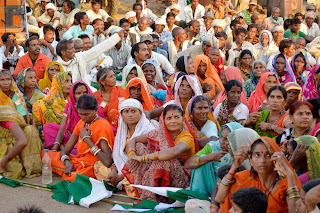India: Between Religious Murder and Secularism
The
nationalism that is been promoted today and the nationalism that was prevalent
during our freedom movement has a vast difference.
One
universal dream of we Indians back then, during the British regime was Nation
building. Moving forward with hope of freedom from the Britishers was the main
aim for us.
And
as for the nationalists today the promotion of hatred is one of the many aims
they try to impose on the young minds. And they have succeeded to a great
extend in promoting that. When we look at the present situation here, tension
and hatred against each other has visibly grown up in recent years.
India’s
National Movement was truly Indian in the respect that it was world’s first
struggle for freedom based on truth and non-violence and its foundations was
laid by the socio-religious reform movement of the 19th century.
As
of the present scenario, religious hatred is on the rise in India, with many
politicians inciting violence and hate to win power. As a society, India must
admit that religious extremism and hatred are deeply entrenched in its
socio-cultural body politic.
On
December 6, 2017, a muslim migrant laborer Mohammed Afrazul, was hacked to
death and set on fire by an unemployed Hindu fanatic Shambhu Lal in a small,
sleepy Indian town of Rajsamand. Afterward, he posted a video of the brutal
murder online, in which he claimed to have murdered Afrazul to avenge the
so-called “love jihad” (a term used by Hindu nationalists to describe a
practice in which Muslim men feign love to draw Hindu women away from their
faith).
Whenever
India raises a step higher on the global barbarity index following such
incidents, the end effect is almost always a polarization of Hindu versus
Muslim. Even the lip service of condemning such despicable incidents does not
remain an honest exercise. Right-wing political parties and cultural groups
start complaining of liberal hypocrisy, of selective outrage, and extol Hindu
sentiments, going back a thousand years. Bulk Whatsapp messages appealing to
the nationalist-cum-religious sentiments are circulated, resulting in sporadic
incidents of violence.
As
a society, India must admit that religious extremism and hatred are deeply
entrenched in its sociocultural body politic. The roots of religious
intolerance are to be found in the collective sub consciousness, which is the
product of historical evolution over the last 5,000 years. Any analysis bereft
of this understanding of the history, twisted to fit political ends, will serve
no purpose except of intellectuals losing credibility.
An
objective and independent inquiry will show that religious extremism and
intolerance are increasing in India, and it is not confined to just one Hindu
community. While analyzing Hindu-Muslim communal tensions in India, any inquiry
bereft of its historical background will not give a complete picture. Muslims
ruled India for more than 1,000 years, from 712 AD through 1857. The common
trend among left-leaning historians is to highlight the phases of communal
harmony and bonhomie between the two communities and hide the instances of
forced conversions, brutal mass slaughter of Hindus and abduction of Hindu
women.
But
North Indian folklore is full of such incidents. During the Raj, the existing
differences between the two communities were aggravated by the British for
political ends. The British policy of appeasement toward Muslim separatism and
extremism widened the rift between Hindus and Muslims and ultimately led to the
partition of India in 1947, followed by violent communal riots on both sides of
the border in which thousands of Hindu and Muslim lives were lost.
Today
most Hindus (though not all) are communal, hating Muslims, and most Muslims
(though not all) are also communal, hating Hindus. How did this happen?
It
has happened because of the power of propaganda. Most People are undoubtedly
good, but they are also simpletons. Propaganda can poison their mind and make
them hate different communities. And modern technology has made Propaganda an
even more powerful weapon in the hands of the tiny, but powerful, wicked
minority.
An example of this is what happened in Germany in the 1930s and 1940s. The Nazi propaganda against the Jews,blaming them for all the ills in Germany (unemployment, inflation, etc ) was so strong that almost the entire German nation at that time went mad, which led to the Holocaust.




Comments
Post a Comment